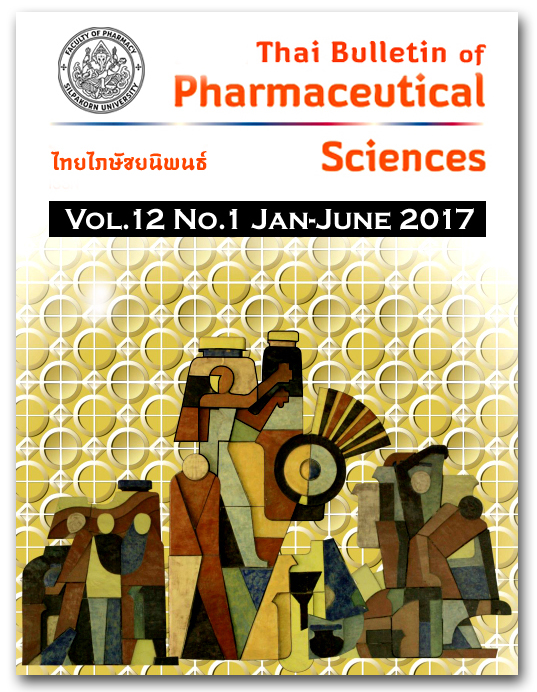การสำรวจโฆษณาที่ผิดกฎหมายของผลิตภัณฑ์เครื่องสำอางในนิตยสารที่จำหน่ายในจังหวัดนครปฐม (A SURVEY OF ILLEGAL COSMETICS ADVERTISEMENTS IN MAGAZINES AVAILABLE IN NAKHON PATHOM PROVINCE)
DOI:
https://doi.org/10.69598/tbps.12.1.33-43Abstract
การโฆษณาเครื่องสำอางเป็นกลยุทธ์ที่ช่วยในการส่งเสริมการขาย แต่ตามกฎหมายว่าด้วยการคุ้มครองผู้บริโภค ผู้ผลิตไม่ต้องขออนุญาตจากภาครัฐก่อนทำการโฆษณา แต่การโฆษณาต้องไม่ฝ่าฝืนกฎหมายของการโฆษณาตาม
พรบ.เครื่องสำอาง พ.ศ. 2535 และ พรบ.คุ้มครองผู้บริโภค พ.ศ. 2522 โดยสื่อนิตยสารเป็นช่องทางที่ผู้บริโภคจะทราบข้อมูลเครื่องสำอางได้มาก ดังนั้นการวิจัยครั้งนี้จึงมีวัตถุประสงค์เพื่อสำรวจและประเมินลักษณะข้อความโฆษณาในนิตยสารตามตัวอย่างข้อความโฆษณาที่ควรหลีกเลี่ยงของงานตรวจสอบโฆษณา และแนวทางการโฆษณาเครื่องสำอาง กลุ่มควบคุมเครื่องสำอาง สำนักงานคณะกรรมการอาหารและยา โดยสำรวจนิตยสารที่มีการโฆษณาเครื่องสำอางทั้งหมด 24 นิตยสารที่จำหน่ายในจังหวัดนครปฐม โดยใช้แบบบันทึกเก็บข้อมูลย้อนหลัง ตั้งแต่เดือนมกราคม ถึง มิถุนายน พ.ศ. 2554 ใช้สถิติเชิงพรรณนา ได้แก่ ความถี่ และร้อยละ ผลการวิจัยพบว่า มีจำนวนข้อความโฆษณาทั้งหมด 1887 ข้อความโฆษณา คิดเป็นร้อยละของข้อความโฆษณาที่ควรหลีกเลี่ยงของงานตรวจสอบโฆษณา กลุ่มควบคุมเครื่องสำอาง สำนักงานคณะกรรมการอาหารและยา 10.57 จำแนกตามกลุ่มเครื่องสำอางบำรุงผิวที่มีสารไวท์เทนนิ่ง กลุ่มเครื่องสำอางลดริ้วรอย กลุ่มเครื่องสำอางสำหรับสิวและกลุ่มเครื่องสำอางกระชับผิว คิดเป็นร้อยละ 5.03, 3.81, 1.62 และ 0.11 ตามลำดับ คิดเป็นร้อยละจำนวนข้อความที่มีแนวโน้มว่าผิด ตามแนวทางการโฆษณาเครื่องสำอาง 63.43 โดยเครื่องสำอางบำรุงผิวที่มีสารไวท์เทนนิ่งพบว่าผิดมากที่สุด (ร้อยละ 35.40) จากการสำรวจสะท้อนให้เห็นว่ามีข้อความโฆษณาจำนวนมาก อาจทำให้ผู้บริโภคเข้าใจผิดได้ ผู้ที่เกี่ยวข้องควรเสริมสร้างศักยภาพให้ผู้บริโภครู้เท่าทันโฆษณาเครื่องสำอาง เพื่อเป็นการคุ้มครองผู้บริโภคต่อไป
Advertising is one method of merchandising strategies. According to the Consumer Protection Law, an organization needs no permission from the government before making an advertisement, but it must be consistent with the advertising laws in the Cosmetics Act, B.E. 2535 and the Cons อางในนิตยสารที่จำหน่ายในจังหวัดนครปฐม (A SURVEY OF ILLEGAL COSMETICS ADVERTISEMENTS IN MAGAZINES AVAILABLE IN NAKHON PATHOM PROVINCE) umer Protection Act, B.E. 2522. Magazine is one of the advertising media which effectively provide consumers with cosmetics information. The objectives of this survey were to inspect and evaluate the inappropriate advertisements based on the examples given by the Food and Drug Administration’s Cosmetic Advertisement Inspection Agency. Twenty-four different magazines available inNakhonPathomProvincewere collected from January to June 2011 and analyzed with descriptive statistics including frequency and percentage. According to the study, out of 1,887 advertisements, 10.57% was found to be avoided based on the Food and Drug Administration’s Cosmetic Advertisement Inspection Agency. All the cosmetics advertisements were categorized into 4 groups: 5.03% whitening cosmetics, 3.81% anti-wrinkle cosmetics, 1.62% anti-acne cosmetics, and 0.11% anti-cellulite cosmetics. In addition, 63.43% of the inappropriate advertisements were likely to be illegal depending on cosmetic advertisement guidelines and 35.40% of this figure was whitening cosmetics. These results reflected that a number of advertisement messages may lead to misunderstanding among consumers. In order to promote consumer safety, involved people should empower consumers to be aware of cosmetics media.
Downloads
Published
How to Cite
Issue
Section
License
All articles published and information contained in this journal such as text, graphics, logos and images is copyrighted by and proprietary to the Thai Bulletin of Pharmaceutical Sciences, and may not be reproduced in whole or in part by persons, organizations, or corporations other than the Thai Bulletin of Pharmaceutical Sciences and the authors without prior written permission.



